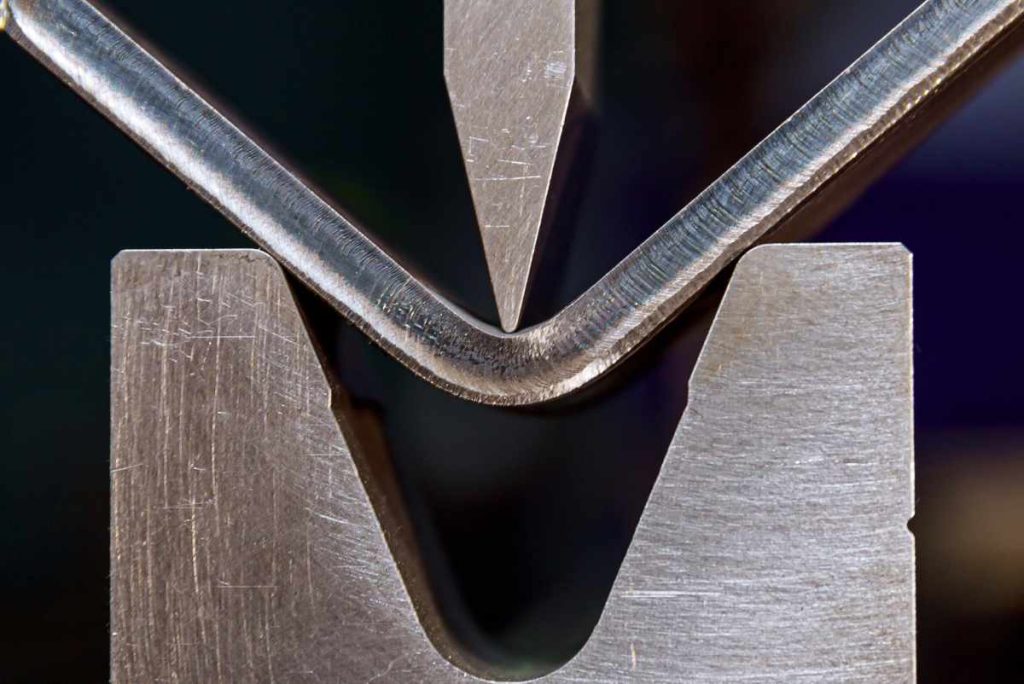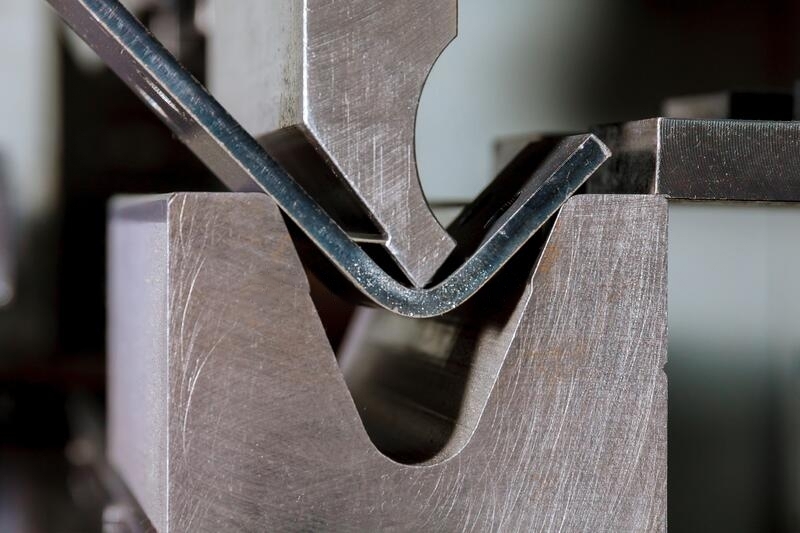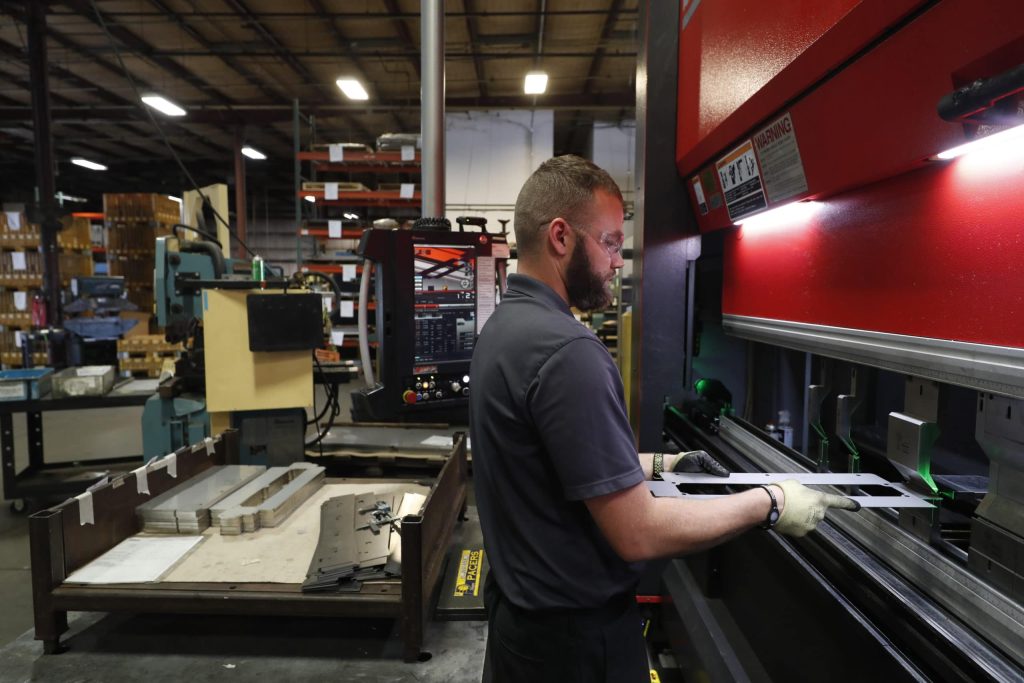Table of Contents

Sheet metal bending
Sheet metal bending is an essential process in manufacturing and fabrication, allowing for the creation of complex shapes and structures from simple flat sheets. Metal bending is widely used in various industries, including automotive, aerospace, construction, and electronics. By understanding the art and science of sheet metal bending, manufacturers can improve their processes, reduce waste, and create high-quality products.
This article will delve into the science behind metal bending, discuss common types of sheet metal bending techniques, and outline essential tools and best practices for successful sheet metal bending. Additionally, this article will explore advanced techniques, common issues, and future advancements in metal bending technology.
What is the Science behind Sheet Metal Bending?
Metal bending involves the application of force to a flat sheet of metal to create a curve or angle. This is achieved by inducing plastic deformation, where the material undergoes a permanent change in shape.
There are many metal properties and operational parameter that determine the metal’s ability to bend without breaking or cracking, such as yield strength, elongation, bend force, etc. Consideration of these factors allows to determine the appropriate bending technique and tools to use for a specific material.
- Yield strength refers to the amount of stress a material can withstand before it begins to deform plastically.
- Tensile strength is the maximum amount of stress a material can handle before breaking.
- Elongation is the material’s ability to stretch or deform without breaking.
- Bending force is the force required to bend the metal, which depends on the material’s thickness and mechanical properties.
- Spring-back is the natural tendency of the metal to return to its original shape after being bent.
- Bend allowance is the length of the material required to accommodate the bend, which varies depending on the material and bending technique.
The Common Types of Sheet Metal Bending Techniques
There are several sheet metal bending types, each with its unique advantages and applications. Some of the most common sheet metal bending techniques include:
| Technique | Description |
|---|---|
| Air bending | Placing the sheet metal on a die and using a punch to apply force, creating a bend. Air bending allows for a wide range of bend angles and minimal contact between the die and the metal, reducing the likelihood of scratches or marks. |
| Bottom bending | Also known as coining, this method involves compressing the sheet metal between a punch and die to create a sharp bend. Bottom bending requires more force than air bending but results in more accurate and consistent angles. |
| V-bending | Utilizes a V-shaped die to create a bend in the sheet metal. V-bending is versatile and suitable for a variety of materials and thicknesses, making it a popular choice for many applications. |
| U-bending | Employs a U-shaped die to create a bend. This method is particularly useful for forming channels or housings. |
| Wipe bending | Using a wiping die to press the sheet metal against a stationary die, creating a bend. Wipe bending is ideal for creating long, straight bends and is often used in the production of door and window frames. |
Press Brake Dies: Essential Tools for Sheet Metal Bending

V-shaped die for sheet metal bending
Press brake dies are critical tools for sheet metal bending, providing the necessary support and force to create precise and accurate bends. There are various types of press brake dies, including V-dies, U-dies, acute angle dies, and hemming dies, each designed for specific bending techniques and applications.
| Die Type | Description | Applications |
|---|---|---|
| V-die | Used in combination with V-bending techniques to create various bend angles | Versatile, ideal for a wide range of applications |
| U-die | Used for U-bending and forming channels or housings | Essential for creating complex shapes, often used in automotive and aerospace industries |
| Acute angle die | Designed for creating bends with smaller angles, typically less than 90 degrees | Ideal for applications requiring precision and accuracy, such as in the medical or electronics industries |
| Hemming die | Used to create hems or folded edges, often found in automotive and aerospace applications | Incredibly versatile, can be used to create a range of shapes and angles |
How to choose the right press brake dies?
When selecting press brake dies, it is essential to consider several factors, including the material, thickness, bend radius, and desired bend angle. Additionally, the die’s material should be harder than the sheet metal being bent, ensuring durability and minimizing wear. Only the press brake die can create high-quality, precise bends that meet the project requirements and specifications.
Step-by-Step Guide: How to Bend Sheet Metal into Desired Shape?
Bending sheet metal involves several steps, from selecting the appropriate tools and materials to following proper bending techniques. Here is a step-by-step guide on how to bend sheet metal:
- Select the appropriate material
Choosing the right type of sheet metal for your project is first step in any metal bending project. While choosing the material, it is crucial to consider various properties, such as yield strength, tensile strength, and elongation are certainly important, there are other factors to keep in mind as well.
Additionally, you must consider its thickness, hardness, and malleability, as well as the intended application. This will help you select the most suitable type of sheet metal for your needs.
- Determine the required bend allowance
Calculate the bend allowance, which is the length of the material required to accommodate the bend. This depends on the material, thickness, and desired bend radius.
The formula to calculate bend allowance in sheet metal bending is;
***BA = (π/180) x B x (R + (K x T))***
Where,
BA = bend allowance
B = bend angle in degrees
R = bend radius
K = K-factor ( a constant that varies depending on the material and bending technique)
and T is the material thickness.
- Choose the appropriate press brake dies
To properly bend sheet metal with a press brake, you need to choose the correct dies based on the type of bending required, the material being used, and the desired bend angle. We already discussed various dies previously, such as air bending, bottom bending, and coining. The material being used also affects the die choice, as different materials require different levels of force and support during bending. Finally, the desired bend angle determines the specific die opening needed for the job.
- Mark the bend line
To ensure precise and accurate bending of sheet metal, mark the bend line using a scribe or marker before proceeding 5. Place the sheet metal on the die
To bend sheet metal correctly, you need to position it accurately on the die. This means lining up the bend line with the edge of the die. Be very careful with the alignment because even a small deviation can cause an improper bend and ruin the sheet metal. Taking the time to position and bend the sheet metal correctly can lead to a great finished product.
- Apply force
It involves applying force to the metal in a specific way to achieve the desired angle. Generally, mechanical or hydraulic punches are used to apply the force in to metal.
- Inspect the bend
Once the bend is created, check the bend for accuracy and if any necessary adjustments to the bending technique or tools are required, go for it.
- Trim or finish the bent sheet metal
To ensure the highest quality of the final product, remove any excess material or burrs from the bent sheet metal. This can be achieved through the use of various tools and techniques, such as sanding or filing. Further more, apply the surface finishing techniques, such as polishing or painting the surface to achieve the desired final look and feel.
Best Practices for Successful Sheet Metal Bending
To ensure successful sheet metal bending, you can adhere the following best practices:
- Understand the material properties: Knowing the material’s yield strength, tensile strength, and elongation can help determine the appropriate bending technique and tools.
- Use the correct bending technique: Choose the sheet metal bending type that best suits the desired application, material, and thickness.
- Select the appropriate press brake dies: Choose press brake dies that match the bending technique, material, and desired bend angle.
- Calculate the bend allowance: Determine the bend allowance to ensure the correct amount of material is used, reducing waste and improving accuracy.
- Apply even pressure: When bending the sheet metal, apply even pressure to ensure consistent and accurate bends.
- Inspect the bend: Regularly inspect the bend to ensure accuracy and make any necessary adjustments.
- Maintain and clean press brake dies: Keep press brake dies clean and well-maintained to ensure their longevity and effectiveness.
Conclusion
Sheet metal bending is an essential process in manufacturing and fabrication, allowing for the creation of complex shapes and structures from simple flat sheets. By understanding the science behind metal bending, selecting the appropriate tools and techniques, and following best practices, manufacturers can improve their processes, reduce waste, and create high-quality products.
At Prolean, we have advanced bending equipment and a dedicated team of engineers for bending and other sheet metal fabrication approaches. If you need consultation or any related services, you can contact us. We will help to expand your business possibilities and innovation, regardless of your industry.
FAQ’s
Q: What is the importance of understanding material properties in sheet metal bending? Understanding material properties, such as yield strength, tensile strength, and elongation, helps manufacturers determine the appropriate bending technique and tools to use for a specific material, ensuring successful sheet metal bending.
Q: What are the most common types of sheet metal bending techniques? A: Some of the most common sheet metal bending techniques include air bending, bottom bending, V-bending, U-bending, and wipe bending.
Q: How do press brake dies contribute to successful sheet metal bending? A: Press brake dies provide the necessary support and force to create precise and accurate bends, ensuring successful sheet metal bending. Selecting the appropriate press brake dies for the bending technique and material is crucial.
Q: How can I prevent common sheet metal bending issues? A: To prevent common sheet metal bending issues such as cracking, warping, or springback, manufacturers should select the appropriate material, calculate the bend allowance accurately, use the correct bending technique, and maintain and clean press brake dies.
Request a quote today!
[contact-form-7 id="1578" title="Contact form"]
Please compress the file into a ZIP or RAR file before uploading. Alternatively, send through your RFQ by email.
enquires@unitymanufacture.com



